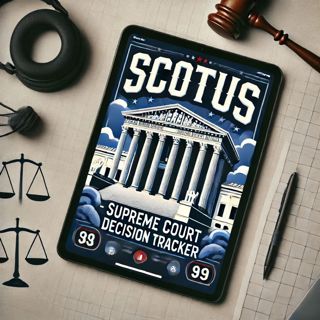
Supreme Court Flexes Executive Power, Sets Sights on Major Constitutional Challenges
Listeners, here’s the latest on the US Supreme Court. The justices have returned from their summer recess and are holding what’s called the “long conference,” which is the first major internal meeting of the new term. During this conference, the court reviews around 2,000 cases submitted over the break, and historically, only a small percentage are accepted for full review. This marks the unofficial start of the court’s October term, with more announcements expected as the justices decide which cases they'll take up in the coming year.One of the most significant recent headlines comes from a Supreme Court decision allowing former President Donald Trump to withhold $4 billion in foreign aid that Congress had already approved. This ruling, which divided the court along ideological lines, gives the president more unilateral control over funds, bypassing the usual process where Congress can weigh in on whether to rescind allocated money. The decision arrives as Washington faces tense negotiations to avoid a government shutdown, putting more power in the executive branch and raising concerns about the constitutional separation of powers.The Supreme Court has also agreed to revisit the landmark precedent known as Humphrey’s Executor v. United States, a 1935 case that set limits on the president’s ability to fire leaders of independent federal agencies. By agreeing to revisit this decision, the justices could dramatically increase presidential authority over a wide range of federal regulators, potentially transforming how independent agencies like the Federal Trade Commission and Securities and Exchange Commission operate.In terms of emergency orders, the justices issued several notable rulings over the past few days. One ruling granted a stay in a major legal battle over the president’s power to withhold congressionally approved funds, reinforcing recent moves to increase executive power. Another emergency order addressed post-conviction relief in a death penalty case from Alabama, temporarily blocking the release of a prisoner while the justices review the underlying legal questions. There’s also an ongoing dispute involving Google and Epic Games, where the Supreme Court may soon decide whether to halt a lower court order that would force Google to change how it manages its app marketplace.Meanwhile, the docket for the coming term is only partially filled, with more cases likely to be added in the weeks ahead. Notably, Ghislaine Maxwell is seeking Supreme Court review of issues related to her prosecution, and there are high-profile challenges involving birthright citizenship and election rules likely to reach the justices before long.These recent moves highlight a Supreme Court that is once again at the center of power struggles between the legislative and executive branches, while also signaling a willingness to take on big constitutional questions that could reshape key government institutions.Thank you for tuning in, and don’t forget to subscribe. This has been a quiet please production, for more check out quiet please dot ai.For more http://www.quietplease.aiGet the best deals https://amzn.to/3ODvOtaThis content was created in partnership and with the help of Artificial Intelligence AI
29 Sep 3min

Supreme Court's Shifting Power Dynamics: Reshaping American Governance
Over the past several days, the Supreme Court has once again taken center stage in national headlines, underscoring both its rapidly evolving direction and the influence of its conservative majority. According to Talking Points Memo, the justices issued a major order that gave a clear early win to President Trump’s controversial “pocket rescissions” theory, which allows the executive branch to indefinitely freeze federal funds that Congress had already appropriated simply by delaying requests until the end of the fiscal year. Legal experts had previously dismissed this argument as implausible, but the Court’s unsigned emergency order signaled openness to Trump’s expansive view of executive spending authority. Justice Elena Kagan, writing for the liberal bloc, strongly cautioned against deciding such far-reaching issues without full briefing and argument, calling it a significant breach in the separation of powers.Daily Kos reports that the Court is not stopping with pocket rescissions. It has moved forward with Trump’s requests on birthright citizenship and agreed to fast-track another monumental case—this one striking at the heart of independent government agencies. The Court agreed to rapidly hear the case of Rebecca Slaughter, a Democratic member of the Federal Trade Commission fired by Trump, despite a 90-year-old precedent, Humphrey’s Executor v. United States, which protects FTC commissioners from being removed without cause. By allowing Trump to dismiss Slaughter immediately and signaling it may revisit that landmark precedent, the justices are poised to give the president the power to remove virtually any agency head or commissioner at will. Analysts warn that if the Court indeed overturns Humphrey’s Executor, it could fundamentally erode the independence of federal agencies and drastically reshape the executive branch.In a related development, Talking Points Memo highlights remarks from Justice Clarence Thomas, who publicly stated that precedent is not “the gospel” and that the justices should not treat past rulings as binding in all circumstances. Thomas’s comments, made at Catholic University, suggest the Court is open to overturning additional landmark rulings, including those protecting access to contraception and same-sex marriage, such as Griswold v. Connecticut, Lawrence v. Texas, and Obergefell v. Hodges. This signals a willingness by the conservative majority to reexamine—and possibly dismantle—foundational elements of modern constitutional law.Beyond the Supreme Court itself, NPR featured reflections from retired Justice Anthony Kennedy on the changing nature of the Court. Kennedy insisted that “the cases swung, not me,” as he considered the widely-discussed ideological drift since his retirement and the striking of the balance on the Court.All of these developments land amid charged political reactions and growing concerns about the Supreme Court’s use of the shadow docket, its approach to precedent, and its direct impact on American governance. The swift actions in high-stakes cases, the willingness to revisit settled law, and the potential to dramatically reshape both agencies and rights are intensifying the spotlight on the Court’s pivotal role in the current political landscape.Thank you for tuning in—be sure to subscribe for more updates. This has been a quiet please production, for more check out quiet please dot ai.For more http://www.quietplease.aiGet the best deals https://amzn.to/3ODvOtaThis content was created in partnership and with the help of Artificial Intelligence AI
28 Sep 3min

Supreme Court Rulings Poised to Reshape Executive Power, Business Landscape
Listeners tuning in to the latest on the U.S. Supreme Court witnessed major headlines and emerging cases that could have sweeping effects on the federal government’s structure, business, and health care policy. This week, a significant focus has been on the Supreme Court’s decision to intervene in Trump v. Slaughter, a case that questions whether presidents can remove commissioners from independent agencies like the Federal Trade Commission without showing cause. President Trump fired Democratic FTC Commissioners Rebecca Slaughter and Alvaro Bedoya earlier in the year, citing policy differences rather than misconduct. Slaughter challenged her removal, leading lower courts to order her reinstatement by referencing the 1935 precedent Humphrey’s Executor v. United States, which generally protects commissioners from removal except for specific failures.On Monday, the Supreme Court granted the Trump administration’s emergency request to stay the reinstatement order, meaning Slaughter remains removed for now. The justices agreed to hear the case on its merits in December and instructed parties to directly address whether the removal protections for FTC commissioners violate the separation of powers and whether Humphrey’s Executor should be overturned. A ruling overturning that precedent would dramatically increase presidential control over independent agencies and reshape how federal regulatory power is wielded.Justice Elena Kagan dissented from the decision to allow the removal to stand for now, joined by Justices Sonia Sotomayor and Ketanji Brown Jackson, arguing that Congress designed independent agencies to be shielded from direct presidential interference. The Court’s move signals a possible dramatic rethinking of constitutional boundaries between the executive branch and federal regulatory bodies.On the business front, another case generating headlines is a Supreme Court review of President Trump-era tariffs. If the justices strike down these tariffs, American businesses could be entitled to up to $80 billion in refunds from the government. The outcome of this pending case stands to have a major impact on U.S. trade policy and economic recovery for affected industries.Meanwhile, AstraZeneca is making a last-ditch appeal to the Supreme Court, challenging the constitutionality of the new Medicare drug price negotiation program. The pharmaceutical giant argues that the program undermines contractual protections and could set new standards for federal involvement in drug pricing. The Court’s response, expected in the coming days, will give insight into how aggressively it might intervene in recent healthcare reforms.Finally, with the Supreme Court’s new term set to begin on the first Monday in October, listeners can expect oral arguments and decisions on a slate of further cases that will likely continue to expand executive power and indicate a conservative drift. Flashpoints slated for review include LGBTQ rights and other constitutional questions, reflecting the justices’ readiness to address issues with social and political resonance.Thank you for tuning in—don’t forget to subscribe. This has been a quiet please production, for more check out quiet please dot ai.For more http://www.quietplease.aiGet the best deals https://amzn.to/3ODvOtaThis content was created in partnership and with the help of Artificial Intelligence AI
26 Sep 3min

Supreme Court Rulings Set to Reshape Executive Power, Trade, and Voting Rights
Over the past several days, the US Supreme Court has made headlines by agreeing to take up significant cases involving presidential powers and federal policy, particularly those impacting President Donald Trump’s agenda. According to SCOTUSblog, the Supreme Court has announced it will hear arguments on November 5 regarding challenges to Trump’s authority to impose sweeping global tariffs under the International Emergency Economic Powers Act. These lawsuits, brought by states and small businesses, challenge the legality and reach of tariffs that could influence trillions of dollars in trade across the next decade. The court's decision in this matter could reshape the scope of executive power in imposing economic restrictions.At the same time, The Journal Record highlights that the Court is moving forward with a case that may dramatically expand the president’s ability to remove leaders from independent federal agencies. This centers on Trump’s firing of Rebecca Slaughter, a Democratic member of the Federal Trade Commission. The Court’s conservative majority permitted the firing to proceed while the case is reviewed, suggesting a serious willingness to revisit or overturn a nine-decade-old precedent that restricts presidents to removing commissioners only for misconduct or neglect of duty. If the Court rules in Trump’s favor, future presidents could gain more direct control over regulatory bodies, potentially altering the balance of independence in federal agencies.In a related development, there has been notable dissent among the justices, particularly from Justice Elena Kagan, Sonia Sotomayor, and Ketanji Brown Jackson, who opposed allowing the firing to stand, pointing to ongoing tensions within the Court over presidential powers and administrative independence. ABC News has reported on these divisions, emphasizing how closely the conservative majority is navigating the boundaries of executive authority.Meanwhile, as the Supreme Court prepares to open its new term in October, major cases on issues like campaign finance, transgender rights, crisis pregnancy centers, and religious liberties are scheduled for review. Campaign organizations and legal groups are already positioning themselves for high-profile oral arguments, knowing the current Court could set transformative new precedents in these areas. Lawyers for Louisiana voters, according to SCOTUSblog, also urged the justices to invalidate a central provision of the Voting Rights Act as part of a dispute over congressional district boundaries, highlighting the ongoing significance of voting rights cases on the docket.Listeners, make sure to stay updated as these decisions develop; they could reshape American governance, law, and society for years to come. Thank you for tuning in, and don’t forget to subscribe. This has been a quiet please production, for more check out quiet please dot ai.For more http://www.quietplease.aiGet the best deals https://amzn.to/3ODvOtaThis content was created in partnership and with the help of Artificial Intelligence AI
24 Sep 3min

Supreme Court Showdown: Executive Powers and Election Law Battles Ahead
Over the past several days, the US Supreme Court has remained at the center of political and legal headlines, particularly focused on presidential removal powers and high-stakes cases scheduled for the upcoming term.A major development involves the continued fallout from President Trump's decision to remove Federal Trade Commissioner Rebecca Slaughter without statutory cause, prompting an ongoing legal battle. Lower courts ordered Slaughter's reinstatement, citing longstanding Supreme Court precedent, specifically the 1935 decision in Humphrey’s Executor v. United States, which ruled that the President cannot remove FTC Commissioners at will but only for cause. Even as the government sought an emergency stay of this decision, the DC Circuit denied the request, explicitly referencing that Supreme Court precedent remains binding and that recent high court decisions reaffirm that removal protections are still fully in effect unless the Supreme Court announces otherwise. These moves underscore an intensifying debate over the limits of executive authority and the independence of federal regulatory bodies.Listeners should note that these removal disputes are part of a broader wave of emergency applications before the Supreme Court, with the government repeatedly asking the justices to stay lower-court rulings that bar presidential firings or policy changes. For instance, recent filings include cases about the President’s power to fire Federal Reserve Board members and to rescind major foreign aid appropriations, with Chief Justice Roberts selectively granting administrative stays or simply requesting responses without granting immediate relief, signaling a nuanced and case-specific approach.Looking ahead to the Supreme Court’s new session, significant cases are poised to shape the country’s legal and political landscape—particularly those related to upcoming elections and federal power. The court has scheduled oral arguments for Bost v. Illinois, which examines whether federal candidates can challenge state rules for federal elections, a case that could open the door to broader election law disputes. Additionally, hearings are scheduled for challenges to President Trump’s tariffs under the International Emergency Economic Powers Act, adding to a docket already filled with crucial disputes over executive action and congressional authority.Another major headline concerns the Supreme Court’s engagement with voting rights and redistricting. A group of Louisiana voters is urging the court to strike down parts of the Voting Rights Act, questioning the constitutionality of creating additional majority-Black congressional districts. The outcome of this case could have broad consequences for how districts are drawn and minority representation in Congress.As the Supreme Court prepares for oral arguments and processes emergency requests at a rapid pace, the larger debate over its independence from Congress continues to swirl. Commentary in outlets like SCOTUSblog reminds listeners that, even amid controversies and calls for court reform, Congress retains significant control over the functioning and jurisdiction of the Supreme Court, shaping the everyday workings of the judiciary at the highest level.Thank you for tuning in and don’t forget to subscribe for the latest courts coverage and legal analysis. This has been a Quiet Please production, for more check out quiet please dot ai.For more http://www.quietplease.aiGet the best deals https://amzn.to/3ODvOtaThis content was created in partnership and with the help of Artificial Intelligence AI
22 Sep 3min

Supreme Court Rulings Strengthen Free Speech, Safeguard Federal Agencies
Listeners, there have been several major developments surrounding the US Supreme Court over the last three days. The biggest headline is the Court's unanimous decision in National Rifle Association of America v. Vullo, announced on September 19. Justice Sonia Sotomayor wrote for the Court, declaring that government officials cannot use threats or coercion to pressure private entities to suppress speech that the government disfavors. This ruling stems from accusations by the NRA that New York’s financial regulator pressured insurance companies and banks to cut ties with the group as a way to stifle its advocacy. Importantly, the Supreme Court stopped short of deciding whether a First Amendment violation had actually occurred, but found the NRA’s claims plausible enough to allow their lawsuit to move forward. Legal experts suggest this decision could set a strong precedent for broadcasters and media organizations if they challenge similar government actions in the future.There has also been significant judicial attention outside the Supreme Court, touching on the power and independence of federal commissions. According to the US Court of Appeals for the DC Circuit, President Trump’s recent removal of Federal Trade Commissioners Rebecca Slaughter and Alvaro Bedoya without statutory cause was ruled unlawful, with the district court ordering Slaughter’s reinstatement. The government tried to block her return pending appeal, but the appellate court dissolved the stay, emphasizing that Supreme Court precedent dating back to Humphrey’s Executor v. United States continues to bar presidents from firing Federal Trade Commissioners at will. The Supreme Court’s reaffirmation of these protections in recent decisions means Slaughter remains in her role for now, barring a change in Supreme Court direction.Listeners should also be aware of the ripple effects these Supreme Court decisions are having across the legal and political spectrum, particularly in First Amendment and executive authority spheres. Commentators are highlighting increased judicial scrutiny on government efforts to remove or sideline officials and the lasting protections given by longstanding Supreme Court precedent.Thanks for tuning in, and don’t forget to subscribe. This has been a quiet please production, for more check out quiet please dot ai.For more http://www.quietplease.aiGet the best deals https://amzn.to/3ODvOtaThis content was created in partnership and with the help of Artificial Intelligence AI
21 Sep 2min

Supreme Court Showdown: High-Stakes Tariffs and Power Struggles to Define the Next Term
Listeners, the latest headlines from the US Supreme Court center around an upcoming blockbuster case on November 5, when the justices will hear arguments over the legality of former President Donald Trump’s global tariffs. This dispute, triggered by Trump’s invocation of emergency powers under the International Emergency Economic Powers Act, challenges the extent of presidential authority to set sweeping tariffs on imports. The Federal Circuit recently ruled that Trump overstepped his authority, siding with 12 state attorneys general who argued the tariffs hurt consumers and businesses. Tariffs remain in place for now, but the Supreme Court’s decision could reshape the balance of power between Congress and the White House on trade policy.Looking at broader Supreme Court news, experts at the Committee for Economic Development of The Conference Board highlight that the upcoming Term—starting the first Monday in October—will be packed with consequential cases beyond the tariffs issue. Major questions about the separation of powers, including redistricting, the right to counsel, workforce protections, copyright, and other topics directly impacting business, are on the docket. Business leaders and policymakers are watching closely, as outcomes could send ripples through government policy and the economy.Another closely watched legal maneuver involves the Federal Reserve. President Trump recently filed an emergency appeal to the Supreme Court seeking permission to remove Fed board member Lisa Cook. Lower courts blocked her removal, citing due process violations, and the administration has escalated the matter in hopes of overturning those rulings. The ongoing dispute underscores mounting political pressure on the Fed’s independence, especially as rate cuts and economic policy adjustments remain in the headlines.Listeners should also be aware of growing legal and political clashes over the First Amendment. Media companies, facing lawsuits and political pressure from the Trump administration, are being criticized for capitulating on issues of free speech—most recently evident in CBS News’ settlement with Trump and the contentious cancellation of popular programming. Concerns are intensifying about the Court’s stance on press freedom and the changing landscape for government regulation of media.Thanks for tuning in, and don’t forget to subscribe. This has been a Quiet Please production, for more check out quietplease.ai.For more http://www.quietplease.aiGet the best deals https://amzn.to/3ODvOtaThis content was created in partnership and with the help of Artificial Intelligence AI
19 Sep 2min

Unprecedented Supreme Court Shadow Docket Usage Raises Transparency Concerns
Major news regarding the U.S. Supreme Court in the last three days centers on the ongoing debate over the Court’s use of its so-called shadow docket, which has reached unprecedented levels in the current term. The shadow docket, traditionally reserved for routine, procedural matters, is now being used far more frequently and for more consequential rulings—often without detailed explanations or disclosure of how individual justices voted. According to SCOTUSblog, the number of emergency matters on the shadow docket has soared from 44 in the previous term to 113 in the current one as of late June, reflecting a dramatic increase under the new presidential administration. Legal experts and commentators, including those quoted in The IE Voice, warn that this trend risks further eroding public confidence in the Court’s transparency and impartiality, especially as the shadow docket is increasingly used for decisions that have significant policy and civil rights implications, such as immigration enforcement and other regulatory actions.Attention has also been drawn to how these emergency rulings, often delivered without full briefing or oral arguments, can leave lower courts and federal agencies uncertain about the reasoning behind the Court’s decisions. Critics argue that this practice undermines the usual process of judicial review and accountability, making it harder for the public to understand or challenge the Court’s actions. The broader concern is that expanded use of the shadow docket contributes to the perception that the judiciary is becoming less transparent and more politically influenced at a time when the balance of power among the three branches of government is already under scrutiny.Looking ahead, the Supreme Court will soon consider a request from the National Basketball Association regarding the Video Privacy Protection Act, with briefing scheduled to conclude and arguments potentially to follow in the coming weeks. This case could have important implications for digital privacy and the scope of protections under federal law, though no decision has been announced as of the last three days.Thank you for tuning in for this quiet please production. For more, check out quiet please dot ai.For more http://www.quietplease.aiGet the best deals https://amzn.to/3ODvOtaThis content was created in partnership and with the help of Artificial Intelligence AI
17 Sep 2min





















